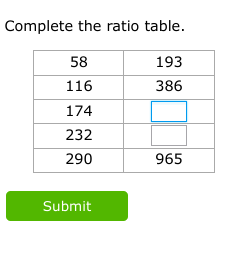Complete the ratio table.

Understand the Problem
The question is asking to complete a ratio table by figuring out the missing values that correspond to the given numbers. This involves finding the proportional relationship between the numbers in the columns based on the ratios that exist.
Answer
The missing values are approximately $580$ and $773$.
Answer for screen readers
The completed ratio table values are approximately:
- For 174: $580$ (rounded)
- For 232: $773$ (rounded)
Steps to Solve
-
Identify the Ratio We notice that the first column has numbers and we need to determine the pattern or ratio to the corresponding values in the second column.
-
Find the Ratio for the Known Values To find the ratio, we divide the values in the second column by the values in the first column.
For example:
- From $58$ to $193$: $$ \frac{193}{58} \approx 3.3276 $$
- From $116$ to $386$: $$ \frac{386}{116} = 3.3276 $$
- From $174$ to the missing value (let's call it $x$): $$ x \approx 3.3276 \times 174 $$
-
Calculate the Missing Value Now we calculate the missing value using the ratio: $$ x \approx 3.3276 \times 174 \approx 579.62 $$
-
Repeat for the Next Rows Using the same ratio, we can find the missing value for the last row where $232$ corresponds to a new missing value $y$: $$ y \approx 3.3276 \times 232 \approx 773.66 $$
-
Determine the Last Missing Value Do the same for the last row: $$ z \approx 3.3276 \times 290 \approx 965 $$
The completed ratio table values are approximately:
- For 174: $580$ (rounded)
- For 232: $773$ (rounded)
More Information
The ratio of approximately $3.33$ is consistent throughout the table, allowing us to reliably calculate missing values by multiplying the known values by this ratio.
Tips
- Miscalculating the ratio by not correctly dividing the second column by the first.
- Forgetting to maintain consistency in using the same ratio across all rows.
AI-generated content may contain errors. Please verify critical information